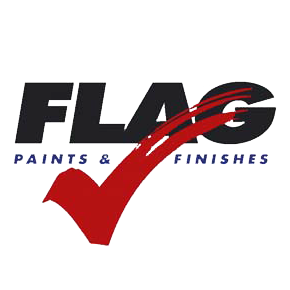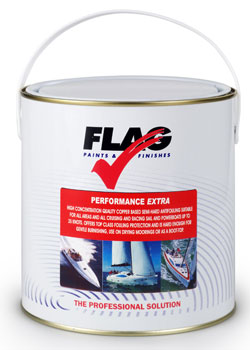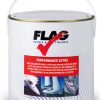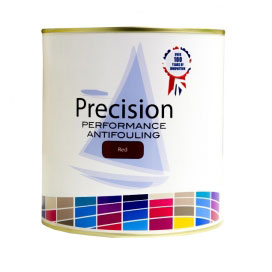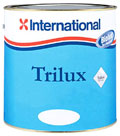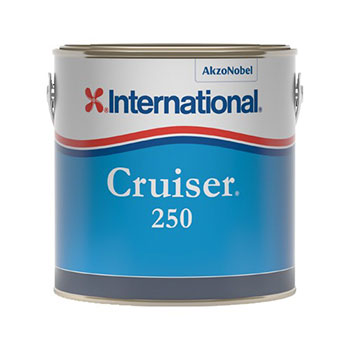Description
Flag Performance Antifouling
Copper based antifouling. Flag Performance Extra Antifouling is semi-hard to enable use in most crafts up to 35 knots but still able to refresh its surface with some mild erosion. Proven performance for all types fouling in all waters. This product is self-priming when topping up existing (similar copper based) antifoulings; otherwise Flag Antifouling Primer or Flag Multi-Purpose Metallic Primer is required. Also suitable for long distance cruisers or racers via the semi-hard nature of the paint system.
Specifications:
- Area of Use: Hulls
- Substrates: GRP, wood, steel and ferro cement. Not suitable for aluminium or galvanised surfaces
- Finish: Matt
- Colour: Steel white
- Volume solids: 75%
- Theoretical spreading rate: 10 sq.metres per litre
- Flash point: 42°C
- Dry to touch: 2 hours
- Overcoating time: 6 hours
- Application method: Brush, Conventional spray, Airless spray, Roller
- Thinners: Flag antifouling thinners
- Cleaning of tools: Flag antifouling thinners
- Surface condition: The surface should be stable, firm, dry and free of dust sand, loose old paint, dirt, grease, oil and salt
Antifouling Tips:
- If no antifouling has been applied to the hull before, it will need to be keyed. Sand it with wet & dry paper and coat it with a primer. (It may also need to be thoroughly cleaned with a solvent to remove any mould release agent)
- On a hull which has been antifouled previously, ensure the new paint is compatible with the old one, or apply a barrier coat (ie. Primer). Ensure the substrate is not flaking; do not dry sand it. If changing to FLAG CopperQuick it is recommended to remove any other non-PTFE based paint first.
- Check the minimum period you need to leave between coats and minimum or maximum time the boat should be left out of the water between painting and relaunching.
- Keep cans of paint indoors until you need them. The paint will be easier to apply if it is not too cold.
- Use good quality masking tape to mask off the waterline. A cheaper one could allow paint to creep underneath for a messy finish and might not peel off cleanly.
- Choose a dry day for painting. A damp atmosphere can adversely effect adhesion.
- Always stir the paint well. And then stir it again before tipping into the paint tray.
- Use either a brush or a roller to apply it, but not too large a roller. A short mohair one is ideal (or sponge roller in the case of FLAG CopperQuick which can also be sprayed).
- Work the brush or roller in a criss-cross pattern, and don’t spread the paint too thinly. Apply an extra coat to all leading and trailing edges, such as the waterline, bow, keels and rudders where applicable.
- Antifoulings change colour after immersion, generally turning a little lighter after a couple of weeks due to oxidation. This also shows the paint is working.
- Do not use Flag copper based antifoulings on aluminium outdrives or zinc anodes.
- Iron keels should be ground and brushed until bright, any rust treated with FLAG Rust Converter and then coated with FLAG Multi Purpose Metallic Primer before antifouling.
- Flag Antifoulings are compatible with most other conventional antifouling but if in doubt, a barrier coat of FLAG Multi Purpose Metallic Primer should be applied first.
To Apply:
- Wear protective clothing and work in an open environment. Overalls, gloves, hat and protective eye wear are essential and a mask is advisable too. Tip: tape up the sleeve cuffs of your overalls with some masking tape to stop paint running up your sleeve when applying overhead.
- STIR THE PAINT! Antifouling paint contains copper which is very heavy and easily settles. Use a flat blade stirring knife or similar (an old screwdriver won’t do!) and when you think you have stirred it enough, stir it again! Keep on stirring it before pouring some out into your roller tray. Tip: Keep the cans indoors before using them as it makes them easier to use and store the cans upside down so you start with the copper at the top.
- Although sprayable, the most common methods used are brush and roller. Use a short mohair or sponge roller suitable for gloss paint (emulsion rollers will disintegrate very quickly). Smaller radiator size rollers are easier to use with such a viscous paint but may take a little longer. Use a brush to reach all the parts inaccessible to the roller. Tip: put your tray inside a polythene shopping bag before use so the tray stays clean.
- Apply a minimum of 2 coats with extra around the waterline, leading and trailing edges and anywhere else where turbulence may occur.
- Ensure the paint has enough time to cure properly before immersion to ensure adhesion. It won’t dry underwater! Applying antifouling in warm windy conditions will accelerate drying but may lead to an orange peel effect finish. Generally FLAG Antifoulings do not need extra thinning but up to 10% can be added to assist applications in quick drying conditions.
- Do not paint over anodes or transducers.
How much paint?
- The most likely reason an antifouling system might under-perform, is that the boat-owner applies it too thinly or skips a coat so that the active ingredient is exhausted early.
- Clearly to make sure you have the right amount of paint, it is important to be able to assess the underwater area of a hull. Preferably you want to do so in square metres as that’s how most paints are quoted these days.
- The formula for doing so is waterline length x (beam + draught) x 0.85 for motor boats, x 0.80 for long keeled yachts and 0.75 for fin keeled yachts.
How it Works:
- All Flag antifoulings work using high concentrations of copper. Copper is a naturally occurring element in our environment and in fact in small concentrations is an essential trace element in plant growth.
- When mixed with a resin binder (and colour of your choice!), the active copper is applied to the bottom of your boat such that some of the copper is always in direct contact with the water. The copper does not poison fouling agents like the old banned TBT (Tri butyl tin), but reacts with sea water to create free ions or charged particles which in turn creates an unfriendly environment for sea creatures to adhere too. (think licking the end of a 9V battery and you’ll get the idea!)
- Flag does not use any additional organic biocides in its formulations, maintaining only the use of naturally occurring inorganic compounds as the active ingredient.
- Flag Performance Extra has one of the highest concentrations of copper currently available and is made hard enough to be used on all types of craft in all environments.
- Flag Antifoulings can be used on all substrates (wood, GRP, steel, ferro etc) except aluminium as galvanic action between the copper and aluminium will lead to serious corrosion.

